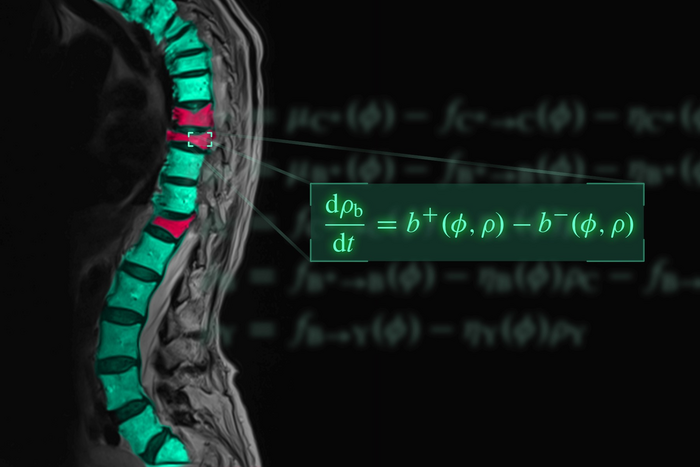The model, described today in eLife, may help improve outcomes for patients with postmenopausal osteoporosis and reduce the risks of side effects by helping physicians build more personalised treatment regimes.

Credit: Spine X-ray image by Friederike Thomasius; image collage created by David Jörg
The model, described today in eLife, may help improve outcomes for patients with postmenopausal osteoporosis and reduce the risks of side effects by helping physicians build more personalised treatment regimes.
The sudden loss of the hormone oestrogen during menopause can interfere with the body’s natural processes for repairing natural wear and tear on bones, leading to more weakened bones and possible fractures. Several drugs are available to treat this type of postmenopausal bone loss. While these treatments can be combined, there is little evidence to suggest what the most effective combinations might be.
“We wanted to know if there are treatment combinations that would work considerably better than those tested and currently used in clinical practice,” says first author David Jörg, Senior Scientist in the Biomedical Modeling and Simulation Group, Fresenius Medical Care Germany, Bad Homburg, Germany. “If so, then this could be beneficial for treating a large number of osteoporosis patients by increasing their bone strength and reducing their risk of bone fracture risk more than standard therapies currently allow.”
To explore this further, Jörg and colleagues built a mathematical model of bone renewal that predicts the effects of various osteoporosis medications in postmenopausal women. They based the model on the latest evidence of how old bone breaks down and new bone is created, as well as how different classes of osteoporosis medications work. They then verified the accuracy of the model by testing its predictions on data from clinical trials.
Next, the team tested the effects of reshuffling the order of different osteoporosis medications. Their model showed that some combinations in a particular order would perform significantly better than others. They also found that combinations that cause the most rapid increases in bone density do not always strengthen bone in the long term and can instead cause a rebound of accelerated bone loss after the treatment stops. “These results show us why the order in which osteoporosis medications are taken is important for short and long-term treatment success in patients,” says co-author Doris Fürtinger, Director of the Biomedical Modeling and Simulation Group, Fresenius Medical Care Germany.
While the model was specific to postmenopausal women, the authors say it could be adapted to help design treatment combinations for patients with bone loss caused by other medications or medical conditions. For example, it could be beneficial for those who take corticosteroid medications or who have hyperparathyroidism and gastrointestinal diseases.
“As our model could potentially predict the effects of a broad range of complex drug combination therapies beyond those used for its development, it could be used for the design of future clinical trials,” says senior author Peter Kotanko, Research Director at the Renal Research Institute, New York, US, and Adjunct Professor of Medicine and Nephrology at the Icahn School of Medicine at Mount Sinai, New York.
Kotanko adds that general limitations of the model need to be considered when using it as a predictive tool, especially when applying the data to extreme dosing regimens, dosing frequencies or age regions beyond those validated in the study. “However, we’ve shown that not only can the model be used as a starting point for forecasting osteoporosis therapy success, but it also highlights the role of mathematical descriptions in helping us understand the biological principles of how drugs work,” he concludes.
##
Media contacts
Emily Packer, Media Relations Manager
eLife
+44 (0)1223 855373
George Litchfield, Marketing and PR Assistant
eLife
About eLife
eLife transforms research communication to create a future where a diverse, global community of scientists and researchers produces open and trusted results for the benefit of all. Independent, not-for-profit and supported by funders, we improve the way science is practised and shared. From the research we publish, to the tools we build, to the people we work with, we’ve earned a reputation for quality, integrity and the flexibility to bring about real change. eLife receives financial support and strategic guidance from the Howard Hughes Medical Institute, Knut and Alice Wallenberg Foundation, the Max Planck Society and Wellcome. Learn more at https://elifesciences.org/about.
To read the latest Computational and Systems Biology research published in eLife, visit https://elifesciences.org/subjects/computational-systems-biology.
And for the latest in Medicine, see https://elifesciences.org/subjects/medicine.
Journal
eLife
DOI
10.7554/eLife.76228
Article Title
Modeling osteoporosis to design and optimize pharmacological therapies comprising multiple drug types
Article Publication Date
9-Aug-2022




